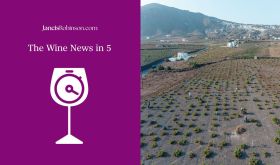South Africa's 2025 harvest
Thank you to Malu Lambert for this – she wrote an incredible overview of the 2025 harvest that we published on Monday. I’m only going to hit the highlights here – you should go read her report. Before I dive in, if you are in the northern hemisphere, flip your seasons around – harvest in South Africa tends to start mid January for sparkling wine.
On the heels of a very difficult growing season preceding the 2024 harvest, in which flooding, as well as wet and cool conditions, challenged winegrowers, the 2025 vintage comes as relief. The country started the season with plenty of moisture to aid vine growth, had very little disease pressure, and generally saw a cool and dry season that allowed fruit to ripen slowly while retaining acidity. There were a few challenges with wind, scattered wildfires, and a heatwave at Christmas but, all in all, it looks to be a promising vintage. Some growers are calling it the best in two decades – but we won’t be able to confirm that until we can taste the wines in another year or so.
A lawsuit against Trump's 'Liberation Day' tariffs
On 14 April the Liberty Justice Center filed a lawsuit against the Trump administration, challenging their authority to issue worldwide tariffs without congressional approval. The lawsuit, filed in the US Court of International Trade, argues that under the International Emergency Economic Powers Act (IEEPA) – which the Trump administration invoked to justify the tariffs – the President would have had to declare a national state of emergency in response to an ‘unusual and extraordinary threat’ to either national security, foreign policy or the US economy, which would have had to originate from outside the US. The lawsuit says that the administration’s justification of a trade deficit is neither a national emergency nor unusual. Jeffrey M Schwab, senior counsel at the Liberty Justice Center, was quoted in the press release of this lawsuit as saying, ‘the Constitution gives the power to set tax rates – including tariffs – to Congress, not the President.’ On 18 April the Liberty Justice Center further filed an application for a temporary restraining order and motion for preliminary injunction which, if approved, would immediately stop enforcement of ‘Liberation Day’ tariffs.
The lawsuit was filed on behalf of five businesses – one of which is New York-based wine importer VOS Selections. The lawsuit, as filed, is called VOS Selections, Inc v Trump. If you are a wine buyer in New York who orders from VOS, please grab another case this week to show your support of owner Victor Owen Schwartz and his team – they’re fighting for all of us.
The OIV's report on the wine sector in 2024
The International Organisation of Vine and Wine, aka the OIV, brings together 50 member countries representing 87% of global wine production to produce standards, technical documents, maintain a database of grapevine varieties, award research grants and gather up-to-date statistics on the wine industry. Their yearly report on the state of the world wine and vine sector is one of the most anticipated of the year and it was released on 15 April.
This year’s report was fairly bleak. Global area under vine contracted for the fourth consecutive year, declining 0.6% to 7.1 million ha. Spain lost the most vineyard area with 14,500 ha pulled in 2024. Of the 25 top wine-producing countries by volume, only Italy, Romania, Greece, Russia, India and Brazil recorded modest expansions. The contraction of vineyards can be attributed to vine-pull schemes due to falling wine consumption.
Wine production, which is linked to hectares under vine but is also closely linked to weather conditions, suffered enormously in 2024. Production dropped 4.8% between 2023 and 2024 to 225.8 million hl – making 2024 the lowest-production year since 1961. This can be attributed to early frosts, heavy rainfall and prolonged drought due to the effects of global warming.
But don’t worry about not having enough wine because wine consumption fell 3.3% in 2024, also reaching the lowest levels since 1961, with 214.2 million hl consumed. This is the seventh consecutive year of declining global consumption. The US and France – the two largest wine-consuming countries in the world – saw a decline in consumption of 5.8% and 3.6% respectively. Overall, declining wine consumption has to do with changing tastes and demographics but there are also inflationary pressures and market uncertainty to consider.
Finally, total global export volumes were only slightly down from last year with 99.8 million hl exported – however this is the lowest export volume since 2010. The only bright spot in this report seems to be that average export price per litre remained relatively high at €3.6, leading to the third-highest recorded level of exports by value. Germany, followed by the UK then the US remain the largest importers of wine by volume with that order reversed if you look at imports by value.
That’s all for this episode of the wine news. If you enjoy this newscast and would like to see it continue, please subscribe to JancisRobinson.com. And if you have breaking news in your area, please email news@jancisrobinson.com.
This is a transcript of our weekly five-minute news broadcast, which you can watch below. You can also listen to it on The Wine News in 5 Podcast. If you enjoy this content and would like to see more like it, please subscribe to our site and our weekly newsletter.














